10+ Email Cover Letter Sample
-
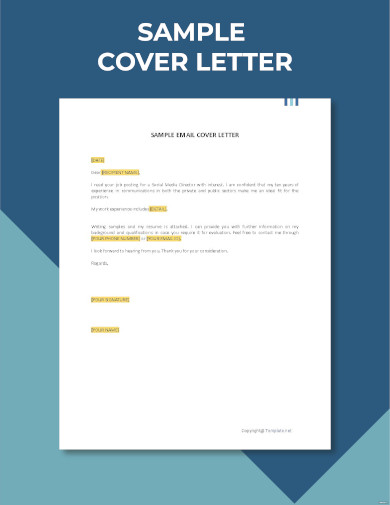
Sample Email Cover Letter
download now -
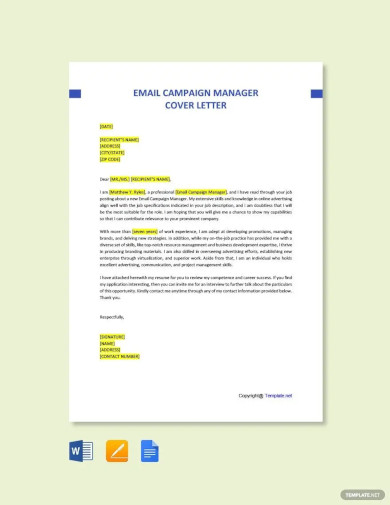
Email Campaign Marketing Manager Cover Letter
download now -
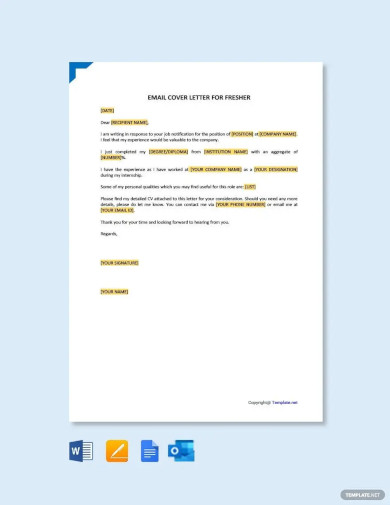
Email Cover Letter for Fresher Template
download now -
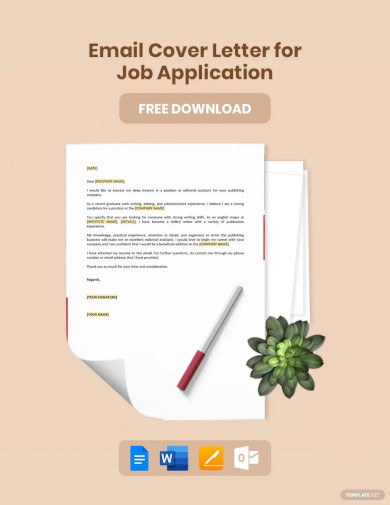
Email Cover Letter For Job Application Template
download now -
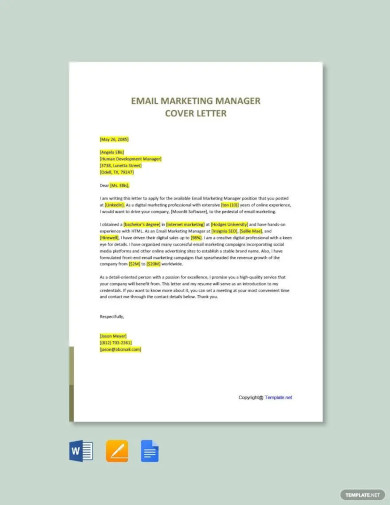
Email Marketing Manager Cover Letter
download now -
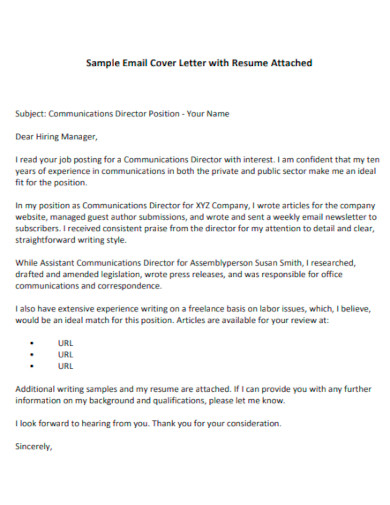
Email Cover Letter with Resume
download now -

An Email Cover Letter
download now -
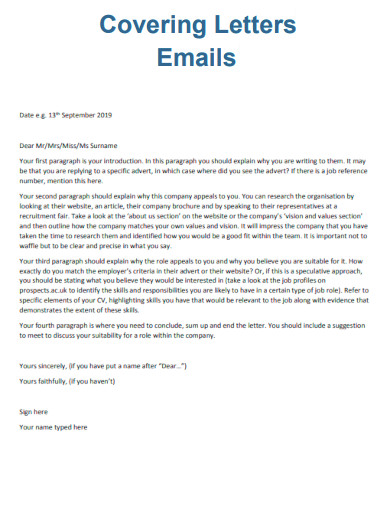
Covering Letters Emails
download now -
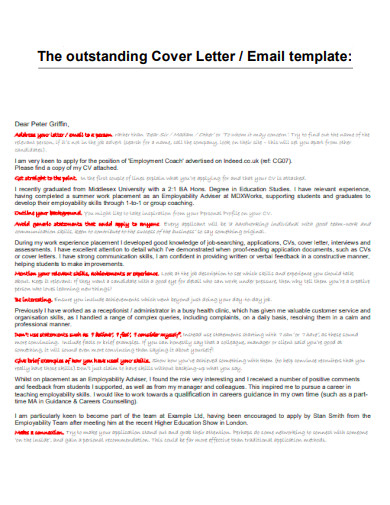
Outstanding Cover Letter Email Template
download now -
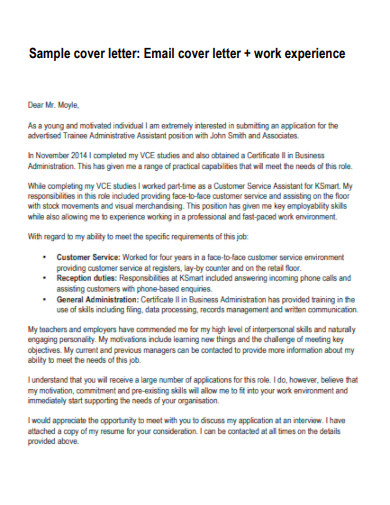
Sample Email Cover Letter and Work Experience
download now -
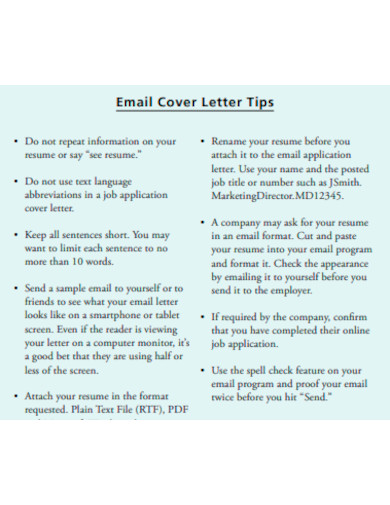
Email Cover Letter Tips
download now
FREE Email Cover Letter s to Download
10+ Email Cover Letter Sample
What Is an Email?
Benefits of Cover Letters
Elements of a Cover Letter
How to Write an Email Cover Letter
FAQs
How do you write a cover letter or resume?
Is a cover letter a writing sample?
What should you do in the first paragraph of the cover letter?
What Is an Email?
Email or electronic mail is the method of transmitting messages/emails stored on a computer/mobile device from one user to multiple users over the Internet. Emails traverse time zones with the tap of a finger and are therefore regarded as an efficient method of communication for both personal and professional uses. The only email requirements are a functional email address, a computer or mobile device, an active internet connection, and the recipient’s email address.
Benefits of Cover Letters
A cover letter is an excellent method to demonstrate your interest in a company and distinguish yourself from other applicants. Numerous applicants refrain from submitting cover letters, so putting in a little extra step will pay off in the long run. The concept is to ensure that you’re composing a proper cover letter: it should be tailored to the position you’re applying for, centered on what you’d bring to the table, and not on what you’d want regarding salary, advancement, or other demands. The following five points discuss the advantages of a cover letter and how composing one can set you apart from the competition.
Elements of a Cover Letter
While cover letter content can differ, all cover letters require a few essential components to serve their purpose and highlight the top reasons to hire you. They should also adhere to a consistent format to make your information easily accessible and well-organized. A strong cover letter employs a logical progression of ideas to highlight your qualifications. Four sections should be included in every cover letter to meet an employer’s expectations and to emphasize your best qualities:
1. Header
Every cover letter should begin with a header containing your contact information. People frequently use the same title for their cover letter and resume to ensure uniformity throughout their application. A header should always begin with your name and include your email, phone number, and address on separate lines, regardless of the format used. Some individuals have connections to their online portfolio or social media profiles if this information is pertinent to the position. Suppose space permits include the recruiting manager’s or company’s name and contact information. People typically have contact information for the employer on their cover letter when submitting a physical copy, but this section of the header is optional.
2. Greeting
Addressing the correct individual in the salutation or greeting of your cover letter is your foremost opportunity to distinguish yourself from other applicants. Researching the name of the recruiting manager for each position demonstrates that you have taken the time and made an effort to apply thoughtfully. Typically, you can discover this information in the job description, on the company’s website, or by calling their office. If you cannot locate a specific name to address your letter, you can personalize the greeting by referencing the department you will be working in. “Dear Hiring Manager” is an acceptable standard salutation when their name is unavailable. Keep your salutation brief and professional, employing appropriate honorifics or titles.
3. Introduction
Your cover letter should present yourself and your reasons for applying for the position shortly. Please have the job title in your cover letter and a basic description of your qualifications for the role and your motivation for using it. If another employee referred you to the position, it would be good to say how you learned about the opportunity and why you chose to apply. Examine the main competencies listed in the job description, and then use your introductory paragraph to discuss how you meet those requirements checklists.
4. Values and Goals
The following paragraph should demonstrate that you are familiar with the organization’s mission statement and have researched the position. Focus on how your objectives align with theirs and how they relate to the company’s culture that you admire. Describe how your work can benefit both your future and the requirements of your prospective employer. This section of your cover letter allows you to demonstrate your ability to perform the job well and work well with others and bring a positive attitude to the workplace. In addition, the call to action should summarize your interest and suggest the next steps in the application process. Thank the recruiting manager for reviewing your employment application and indicating your interest in further discussion or an interview schedule. Your cover letter must explain how you can benefit the company, so emphasize the skills and abilities you can offer to the team. Use a formal concluding phrase and your signature or typed name to sign off. If you are emailing your cover letter, be sure to omit a superfluous email signature.
How to Write an Email Cover Letter
The modern job application process requires writing a cover letter via email. You may want to append a cover letter to your job application, but there is no option. Or, include your cover letter in the body of your email to capture the attention of the recruiting manager before they decide to download your resume. Here are five tips on formatting and writing an effective email cover letter if you’re still intrigued.
1. Make It Simple to Comprehend
The average recruiter spends minimal time reviewing emails. If you want your employment to be considered, your email cover letter format must be plain and straightforward to read, even on a smartphone. Each paragraph should consist of between one and three sentences. You must also include a distinct introduction, body, and conclusion so hiring managers can quickly locate the information they seek.
2. Be Precise and Concise
When composing an email cover letter, the key is to be concise yet informative. To persuade the recruiting manager to consider your application, briefly describe yourself, your experience, qualifications, and skills. Going on and on about your accomplishments and reasons for wanting the job can be compelling. However, you should edit your email cover letter to include only pertinent and essential information. For example, your email cover letter must contain a maximum of a few sentences about your personal history or interests.
3. Include an Informative Subject Line
For a job application to be successful, the email subject line must be catchy. Even if your CV and cover letter are excellent, hiring managers will only check your email if the subject line is clear. Potential employers will first view your topic line. This rule only doesn’t apply if the employer for the position you’re looking for has a particular format they want you to use in your subject line. To make sure this is the case, double-check the listing.
4. Personalize the Reader’s Email
Ensure you address the hiring manager in your email cover letter because people (even hiring managers) pay far more attention when they hear or read their names. In addition, you can consider other options for “Dear Sir to Madam” writing. Using “Dear Hiring Manager” as the salutation at the beginning of your email is acceptable if all else fails. But try to bypass it if you can. Learn the recruiting manager’s name and position to address a cover letter correctly.
5. Conclude with a Convincing Final Paragraph
Your email cover letter closing should encourage the recruiting manager to contact you to initiate the hiring process’s next phase. In particular, restate your enthusiasm for the job and your availability for interview questions. The conclusion of your email should be confident but not insistent or frantic. Ensure you’re interested and available, but avoid pressuring the recruiting manager to respond. Finally, conclude your email with an HR-approved sign-off such as “Sincerely,” “Regards,” or “Best regards.”
FAQs
How do you write a cover letter or resume?
Your cover letter should include a specific reference to the position you’re applying for. Although some details may be found in both papers, a cover letter often focuses more on present and future goals, while a resume lists previous employment and achievements.
Is a cover letter a writing sample?
No, your cover letter does not serve as a writing sample, but it must be flawless if you seek a writing position as a continuation. Whether the employer initially requested a writing sample or not, they may later request a specific writing sample or a customized sample.
What should you do in the first paragraph of the cover letter?
In the first paragraph, describe the purpose of your letter and the position or line of work you are applying for. Describe how you learned about the opening. Second: Describe your interest in the role, the business proposal, and the products. Briefly describe your background (skills, achievements, and abilities).
According to the adage, the first impression is the most important, so ensure that your digital introduction accurately represents you. Apply your best judgment to each position you apply for; for an entry-level position, keep your cover letter concise, while for higher-level positions, go into greater detail and provide more information sheets. These tips are meant only as a starting point; add your voice, style, and experience to create an outstanding email cover letter. Start crafting cover letters that will help you stand out and secure the position!
